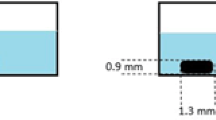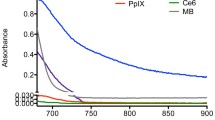Abstract
This study aims to compare the continuous irradiation with fractionated irradiation for photodynamic therapy (PDT) of solid tumors with intraperitoneally administered 5-aminolaevulinic acid (ALA). Therefore, considering the complex physiology of solid tumors and in order to inform simulations well, we did experiments on Balb/c mice using non-invasive fluorescence spectroscopy to have a feedback of protoporphyrin IX (PpIX) concentration in tumor just before irradiation and during treatment. PDT simulations were performed based on delivery of 36 J cm−2 total laser energy (630 nm) at the fluence rate of 40 mW cm−2 either for continuous or fractionated illumination. Based on the calculated amounts of 1O2 dose deposition and comparing these amounts with the 5 × 10 18 molecules cm−3 threshold of reacting 1O2, simulation results demonstrate that fractionated illumination with alternating light and dark periods of 60 s improved the tumor response further for PpIX-mediated PDT.







Similar content being viewed by others
References
Wilson BC, Patterson MS (1986) The physics of photodynamic therapy. Phys Med Biol 31(4):327–360
Oleinick NL, Evans HH (1998) The photobiology of photodynamic therapy: cellular targets and mechanisms. Radiat Res 150:S146–S156
Dougherty TJ, Gomer CJ, Henderson BW, Jori G, Kessel D, Korbelik M, Moan J, Peng Q (1998) Photodynamic therapy. J Natl Cancer Inst 90(12):889–905
Moan J, Peng Q (2003) An outline of the hundred-year history of PDT. Anticancer Res 23(5A):3591–3600
Brown SB, Brown EA, Walker I (2004) The present and future role of photodynamic therapy in cancer treatment. Lancet Oncol 5(8):497–508
Tromberg BJ, Orenstein A, Kimel S, Barker SJ, Hyatt J, Nelson SJ, Berns MW (1990) In vivo tumor oxygen tension measurements for the evaluation of the efficiency of photodynamic therapy. Photochem Photobiol 52(2):375–385
Panjehpour M, Overholt BF, Denovo RC, Peterson MG, Sneed RE (1993) Comparative study between pulsed and continuous wave lasers for Photofrin® photodynamic therapy. Lasers Surg Med 13(3):296–304
Miyamoto Y, Umebayashi Y, Nishisaka T (1999) Comparison of phototoxicity mechanism between pulsed and continuous wave irradiation in photodynamic therapy. J Photochem Photobiol B 53(1–3):53–59
Chen Q, Huang Z, Chen H, Shapiro H, Beckers J, Hetzel FW (2002) Improvement of tumor response by manipulation of tumor oxygenation during photodynamic therapy. Photochem Photobiol 76(2):197–203
Xiao Z, Halls S, Dickey D, Tulip J, Moore RB (2007) Fractionated versus standard continuous light delivery in interstitial photodynamic therapy of dunning prostate carcinomas. Clin Cancer Res 13(24):7496–7505
Robinson DJ, de Bruijn HS, de Wolf WJ, Sterenborg HJCM, Star WM (2000) Topical 5-aminolevulinic acid-photodynamic therapy of hairless mouse skin using two-fold illumination schemes: PpIX fluorescence kinetics, photobleaching and biological effect. Photochem Photobiol 72(6):794–802
Babilas P, Schacht V, Liebsch G, Wolfbeis Otto S, Landthaler M, Szeimies RM, Abels C (2003) Effects of light fractionation and different fluence rates on photodynamic therapy with 5-aminolaevulinic acid in vivo. Br J Cancer 88(9):1462–1469
Pogue BW, Braun RD, Lanzen JL, Erickson C, Dewhirst MW (2001) Analysis of the heterogeneity of pO2 dynamics during photodynamic therapy with verteporfin. Photochem Photobiol 74(5):700–706
Sheng C, Hoopes JP, Hasan T, Pogue BW (2007) Photobleaching-based dosimetry predicts deposited dose in ALA-PpIX PDT of rodent esophagus. Photochem Photobiol 83(3):738–748
Kruijt B, de Bruijn HS, den Heuvel A, de Bruin RWF, Sterenborg HJCM, Amelink A, Robinson DJ (2008) Monitoring ALA-induced PpIX photodynamic therapy in the rat esophagus using fluorescence and reflectance spectroscopy. Photochem Photobiol 84(6):1515–1527
Dysart JS, Patterson MS (2006) Photobleaching kinetics, photoproduct formation, and dose estimation during ALA induced PpIX PDT of MLL cells under well oxygenated and hypoxic conditions. Photochem Photobiol Sci 5:73–81
Borere IA, Robinson DJ, de Bruijn HS, Kluin J, Tilanus HW, Sterenborg HJCM, de Bruin RWF (2006) Protoporphyrin IX fluorescence photobleaching and the response of rat Barrett’s esophagus following 5-aminolevulinic acid photodynamic therapy. Photochem Photobiol 82(6):1638–1644
Orenstein A, Kostenich G, Roitman L, Shechtman Y, Kopolovic Y, Ehrenberg B, Malik Z (1996) A comparative study of tissue distribution and photodynamic therapy selectivity of cholorin e 6 , Photofrin II and ALA-induced protoporphyrin IX in a colon carcinoma model. Br J Cancer 73:937–944
Zhu TC, Finlay JC, Zhou X, Li J (2006) Modeling of singlet oxygen during photodynamic therapy using COMSOL multiphysics. Proceedings of COMSOL Users Conference, Boston, 2006
Foster TH, Murant RS, Bryant RG, Knox RS, Gibson SL, Hilf R (1991) Oxygen consumption and diffusion effects in photodynamic therapy. Radiat Res 126(3):296–303
Wang KKHW, Mitra S, Foster TH (2008) Photodynamic dose does not correlate with long-term tumor response to mTHPC-PDT performed at several drug-light intervals. Med Phys 35(8):3518–3526
Dysart JS, Patterson MS (2005) Characterization of Photofrin photobleaching for singlet oxygen dose estimation during photodynamic therapy of MLL cells in vitro. Phys Med Biol 50(11):2597–2616
Dysart JS, Singh G, Patterson MS (2005) Calculation of singlet oxygen dose from photosensitizer fluorescence and photobleaching during mTHPC photodynamic therapy of MLL cells. Photochem Photobiol 81(1):196–205
Jones LR, Preyer NW, Wolfsen HC, Reynolds DM, Davis MA, Wallace MB (2009) Monte Carlo model of stricture formation in photodynamic therapy of normal pig esophagus. Photochem Photobiol 85(1):341–346
Farrell TJ, Wilson BC, Patterson MS, Olivo MC (1998) Comparison of the in vivo photodynamic threshold dose for Photofrin, mono-and tetrasulfonated aluminum phthalocyanine using a rat liver model. Photochem Photobiol 68(3):394–399
Wilson BC, Patterson MS (2008) The physics, biophysics and technology of photodynamic therapy. Phys Med Biol 53:R61–R109
Lagerlund TD, Low PA (1991) Axial diffusion and Michaelis–Menten kinetics in oxygen delivery in rat peripheral-nerve. Am J Physiol 260(2):R430–R440
Lagerlund TD, Low PA (1993) Mathematical-modeling of time-dependent oxygen-transport in rat peripheral-nerve. Comput Biol Med 23(1):29–47
Georgakoudi I, Foster TH (1998) Singlet oxygen- versus nonsinglet oxygen-mediated mechanisms of sensitizer photobleaching and their effects on photodynamic dosimetry. Photochem Photobiol 67(6):612–625
Georgakoudi I, Nichols MG, Foster TH (1997) The mechanism of photofrin photobleaching and its consequences for photodynamic dosimetry. Photochem Photobiol 65(1):135–144
Wang KKHW, Cottrell WJ, Mitra S, Oseroff AR, Foster TH (2009) Simulations of measured photobleaching kinetics in human basal cell carcinomas suggest blood flow reductions during ALA-PDT. Lasers Surg Med 41(9):686–696
Liu B, Farrell TJ, Patterson MS (2010) A dynamic model for ALA-PDT of skin: simulation of temporal and spatial distributions of ground-state oxygen, photosensitizer and singlet oxygen. Phys Med Biol 55(19):5913–5932
Juzenas P, Juzeniene A, Stakland S, Iani V, Moan J (2002) Photosensitizing effect of protoporphyrin IX in pigmented melanoma of mice. Biochem Biophys Res Comm 297(3):468–472
Naghavi N, Miran Baygi MH, Sazgarnia A (2010) Determination of time-dependent protoporphyrin IX concentration for photodynamic therapy dosimetry in a mice colon tumor model using fluorescence spectroscopy. Appl Spectrosc J 64(12):1350–1354
Chen Q, Chen H, Hetzel FW (1996) Tumor oxygenation changes post-photodynamic therapy. Photochem Photobiol 63(1):128–131
Ascencio M, Estevez JP, Delemer M, Farine MO, Collinet P, Mordon S (2008) Comparison of continuous and fractionated illumination during hexaminolaevulinate-photodynamic therapy. Photodiag Photodyn Ther 5(3):210–216
Curnow A, Haller JC, Bown SG (2000) Oxygen monitoring during 5-aminolaevulinic acid induced photodynamic therapy in normal rat colon. Comparison of continuous and fractionated light regimes. J Photochem Photobiol B. 58(2–3):149–155
Curnow A, Mcllroy BW, Postle-Hacon MJ, MacRobert AJ, Bown SG (1999) Light dose fractionation to enhance photodynamic therapy using 5-aminolevulinic acid in the normal rat colon. Photochem Photobiol 69(1):71–76
Jarvi MT, Niedre MJ, Patterson MS, Wilson BC (2006) Singlet oxygen luminescence dosimetry (SOLD) for photodynamic therapy: current status, challenges and future prospects. Photochem Photobiol 82(5):1198–1210
Acknowledgments
This work was supported by grant from Tarbiat Modares University (TMU) 403/1514.
Author information
Authors and Affiliations
Corresponding author
Rights and permissions
About this article
Cite this article
Naghavi, N., Miranbaygi, M.H. & Sazgarnia, A. Simulation of fractionated and continuous irradiation in photodynamic therapy: study the differences between photobleaching and singlet oxygen dose deposition. Australas Phys Eng Sci Med 34, 203–211 (2011). https://doi.org/10.1007/s13246-011-0064-6
Received:
Accepted:
Published:
Issue Date:
DOI: https://doi.org/10.1007/s13246-011-0064-6




